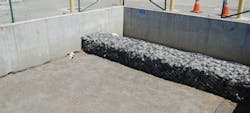Considerations for Regional Retrofit of Treatment BMPs
In recent years, stricter regulations have presented communities with numerous challenges to mitigating pollutants in developed areas. NPDES permits are increasing requirements to apply pollutant control measures that ensure protection of downstream water bodies, and to implement appropriate measures that address 303(d)-listed impaired water bodies and their resultant total maximum daily loads (TMDLs). There is a heavy emphasis on infiltration and vegetative BMPs, often with the need
to retrofit treatment BMPs into
existing developments.
When identifying potential BMP site locations several factors must be considered, including watershed analysis and identifying land use characteristics and specific pollutants of concern. For example, for an industrial facility in a large urban watershed, an analysis of the watershed might show a large presence of sediment and heavy metals. Residential developments may generate more nutrients and bacteria. Land use characteristics that are important to consider include land availability, topography, soil type, land ownership and maintenance access. Depending on downstream impairments, some land uses are of more concern than others. For example, the Los Angeles River is impaired for metals.
When considering the best BMP selection for a retrofit, it is important to evaluate pollutant removal capabilities, examine downstream water quality objectives, review life-cycle costs, ensure aesthetic appeal to the community
and treat appropriate drainage areas. Treatment BMPs suitable for regional retrofit include detention or retention ponds, constructed wetlands, infiltration devices and
sand filters.
Infiltration BMPs have the greatest potential for pollutant load reduction. Preliminary screening of the hydrologic soil groups can determine feasibility for infiltration. Once identified, BMPs and their locations should be prioritized based on, in order, constructability based on site constraints; total cost associated with implementation; and strategic placement—determining where treatment would provide the greatest water quality benefit. In the industrial facility example, an appropriate BMP for treating heavy metals would be a media filter.
An optimal place to design and retrofit a treatment BMP is on publicly owned land located near existing storm water infrastructure. This type of implementation makes use of the existing storm drain infrastructure, with minor reconfiguration of drainage system segments.
By following the steps of watershed analysis and land use characterization, pollutant identification, and BMP selection and prioritization, the ideal BMP can be selected, designed and implemented to improve water quality and maintain or attain designated beneficial uses.
Download: Here
